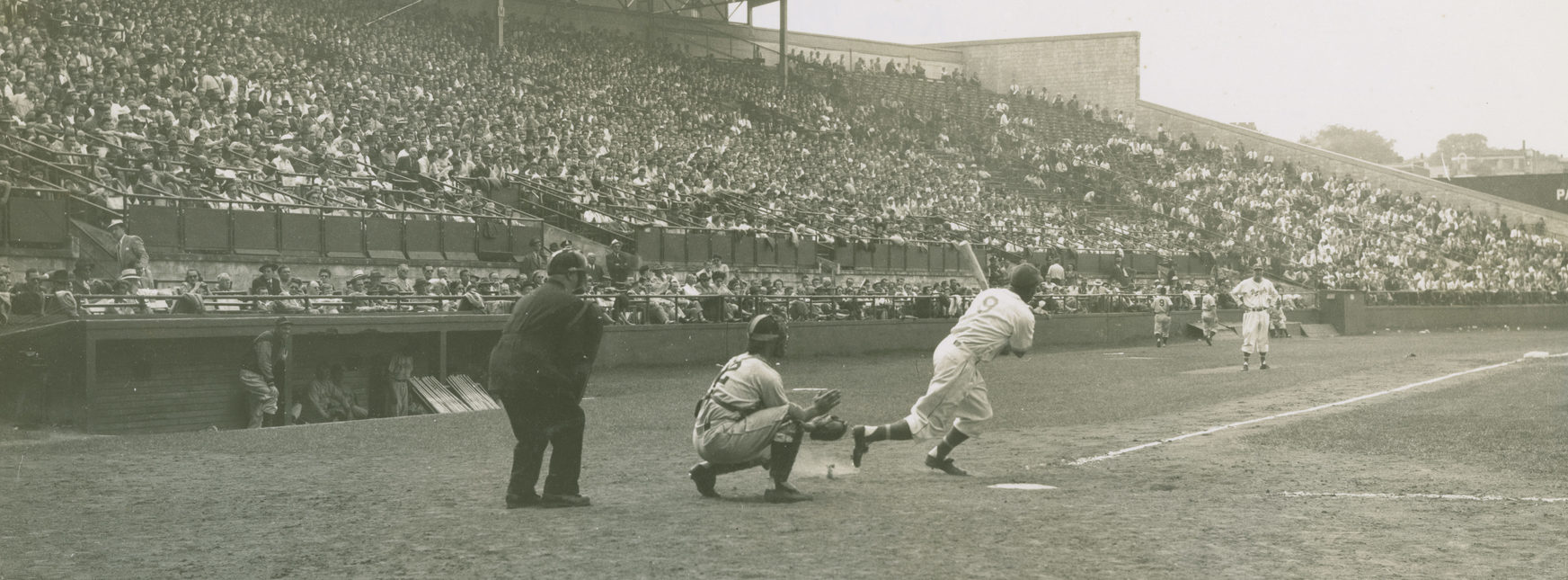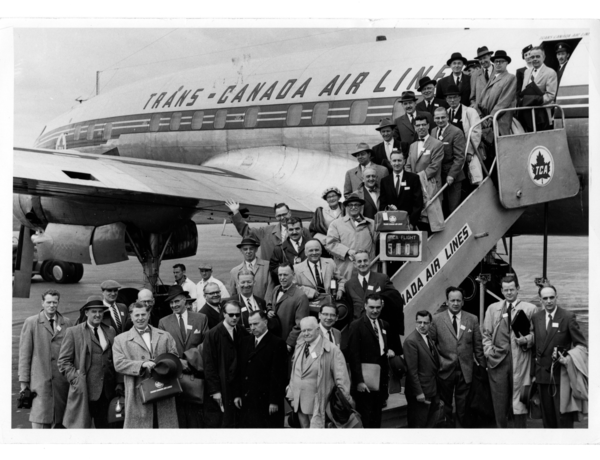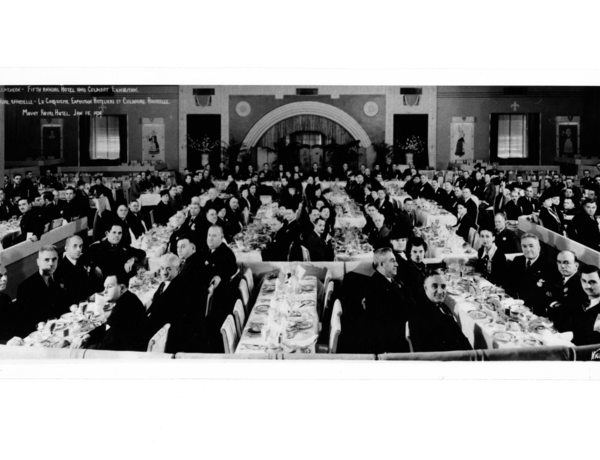History of Tourisme Montréal
1919: Tourisme Montréal is founded
On October 8, 1919, the Automobile Club of Canada (the predecessor of CAA-Québec) founded the Tourist Bureau of Montreal with support from the municipal government and several big names in local industry, including Henry Birks & Sons, Henry Morgan & Company, Holt Renfrew, Canada Steamship Lines, Canadian National Railways, the Windsor Hotel, the Ritz-Carlton, the Retail Merchants Association and Montréal’s chamber of commerce. The mission of the new organization was to promote Montréal and its road network in order to develop tourism. That same year, some 18,105 cars brought tourists into Québec according to statistics from the Department of Highways and Mines.
In 1924, the Tourist Bureau of Montreal was renamed the Montreal Tourist and Convention Bureau as part of a broader effort to boost business travel to the city. Montréal was promoted with slogans like “Cosmopolitan Montreal” and “Abroad Without Crossing the Sea” (1925).
In 1929, Montréal hosted 89 conventions, 48 of which were international. Some 524,000 vehicles crossed into Quebec from the United States for tourism purposes, with 320,000 entering for stays lasting more than 24 hours. Spending by international tourists visiting Québec reached $9.2 million that year according to estimates from the Dominion Bureau of Statistics, the precursor to Statistics Canada.
Canada’s metropolis
At the turn of the 20th century, Montréal was North America’s second-largest port city, a major railway hub and the centre of Canadian commerce and finance. As tourism to Montréal grew, so did the city’s transport infrastructure and hotel network.
On April 1, 1939, Trans-Canada Air Lines (now Air Canada) launched a passenger flight service between Montréal and Vancouver. International tourism took off with the opening of Dorval Airport in 1941, and the first transatlantic flight departed from Montréal in 1943. That same year, more than 450,000 cars carrying American tourists entered Québec, with nearly 260,000 staying over 48 hours, representing $33.9 million in tourist spending. The following year, Montréal got its first convention centre. At the time, tourism promoters emphasized Montréal’s historic and romantic charm, using the slogan “The Gateway to Historic Québec.”
Unsurprisingly, World War 2 had an impact on local tourism. For one thing, travellers favoured the train over the car for trips between Canada and the United States. In 1943, 212,000 American rail passengers entered Québec, a 28% increase from the previous year. Tourist spending followed a similar trajectory, amounting to $20 million.
Montréal received one million tourists in 1949 according to information gathered by the Montreal Tourist and Convention Bureau, which had 245 members at the time.
Transformation and renewal
In 1961, the Montreal Tourist and Convention Bureau changed its focus to business tourism and was renamed the Montreal Convention and Visitors Bureau, while responsibility for leisure tourism was transferred to the new Municipal Tourism Office. In 1964, the organization’s president set up a committee tasked with intensifying the promotion of Montréal on the conventions and meetings market. The following year, Montréal welcomed 67,545 delegates attending 161 different conventions. At the time, the Montreal Convention and Visitors Bureau had 274 members.
Combining North American comfort and European charm, Montréal has long enjoyed a reputation as the “Paris of North America.” The 1960s marked the beginning of Montréal’s transformation into an unmistakably modern metropolis. Key projects from this era included the redevelopment of Place Jacques-Cartier and the construction of Place Ville-Marie and Place des Arts. This renewal occurred against the backdrop of the Quiet Revolution and the democratization of air travel, which led to a sharp increase in the number of tourists visiting the city.
On the year of its 50th anniversary, the Montreal Convention and Visitors Bureau had more than 300 members.
A dynamic destination
Two major events would earn Montréal its status as a city that is open to the world: Expo 67 and the 1976 Olympics. In 1976, international arrivals (excluding tourists from the United States) jumped 24% to reach 355,000 visitors.
In 1982, the Montreal Convention and Visitors Bureau became the Greater Montréal Convention and Tourism Bureau (GMCTB). Always a major player on Montréal’s tourism scene, the GMCTB would play a key role in the construction of the Palais des congrès convention centre the following year.
In 1986, the Chairman of the Board at the GMCTB initiated a strategic planning process that led to the unification of Montréal’s most important tourism bodies.
In 1989, the GMCTB merged with CIDEM-Tourisme (formerly the Municipal Tourism Office). The organization now had 402 members and 51 employees. That same year, the City of Montréal launched the Infotouriste Centre in conjunction with the provincial and federal governments. This multifunctional welcome office was managed by the Société d’accueil et de renseignements touristiques de Montréal (SARTM), an agency backed by the municipal government.
In 1992, the City of Montréal made the GMCTB responsible for the hospitality role previously held by the SARTM, and the organization helped promote Montréal’s 350th anniversary.
On May 19, 1994, the GMCTB celebrated its 75th anniversary at Marché Bonsecours. To mark the occasion, the organization presented an exhibit on the history of tourism in Montréal at the Centre d’histoire de Montréal.
In 1995, the GMCTB launched its first website. This marked the organization’s first incursion into new technologies, which would eventually play an essential role in promoting Montréal as a destination.
In spite of the ups and downs of the global economy, Montréal attracted over 7 million tourists between 1997 and 2005, achieving the best performance in the industry in Canada. The strategic positioning at the time presented Montréal as a centre of francophone culture and a romantic, dynamic, safe and welcoming destination. The slogan chosen for the conventions market was “Montréal, A Convention City. Not a Conventional City.”
In 1998, the GMCTB changed its name to Tourisme Montréal. With the introduction of the accommodation tax in 1997, the organization had the resources to intensify promotional efforts on the international stage. It promoted Montréal as an ideal year-round urban destination featuring unique and festive experiences. Montréal became North America’s second-biggest destination in the international conventions market.
In 2013, Tourisme Montréal allocated over $10 million to promote the city and stimulate the growth of tourism. It anticipated the arrival of 8.5 million visitors representing $2.5 billion in tourist spending.
With the emergence of social media, consumer habits began to change, and the role of tourism agencies had to evolve to keep pace. Always at the forefront of new technology, Tourisme Montréal adopted the #MTLmoments hashtag and released a mobile-friendly version of its Vivez MTL / MTL Buzz blog for smartphones and tablets. The organization shifted its focus away from traditional advertising and opted for themed campaigns that highlighted specific tourism selling points like Montréal’s festival and music scene, dining options and family-friendly tourism. That same year, Montréal hosted more conventions than any other Canadian city.
2013 was also the year Tourisme Montréal launched the “Fais-le à Montréal / Do Your Thing” campaign. In a series of videos, influencers and other stars from North America’s LGBT community showed their talent and shared their vision of Montréal. The aim was to promote Montréal as a leading LGBT destination.
Between 2015 and 2017, the number of tourists visiting Montréal rose from 9.6 million to just over 11 million, a new record.
In 2016 and 2017, Tourisme Montréal played a key role in promoting Montréal’s 375th anniversary with the “Sorry” campaign in the Ontario and US markets. The three-staged campaign centred on a humorous message: “Dear neighbours from Toronto and New York, we’re turning 375 in 2017 so we’ll be celebrating all year! We’re going to make a lot of noise…Sorry! We live right next door so, of course, you’re welcome to come and join us. Your neighbour, Montréal.”
Tourisme Montréal in 2019: 1,000 members and partners, 100 dedicated employees and 1 city-sized playground
In early 2018, Tourisme Montréal adopted a new set of strategies that would redefine its role and activities with tourism markets and stakeholders in the 2018–2022 period. Over the past 100 years, Tourisme Montréal has developed exceptional expertise in promoting Montréal as a travel destination. The organization is deeply involved in the local community and has earned recognition for its innovative practices. It is dedicated to maximizing the social and economic spinoffs of tourism in the city, and it plays a vital role in Montréal’s tourism ecosystem.
As Tourisme Montréal celebrates its 100th anniversary, it remains steadfast in its belief that Montréal is not only the gateway to Quebec, but it is on its way to becoming one of North America’s leading tourist destinations. To make this vision a reality, Tourisme Montréal is promoting the city’s fun side by presenting it as a giant playground where anything is possible.


